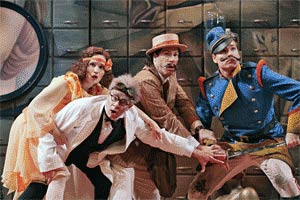
Last summer, I had the chance to hear Britten's
Gloriana from
Opera Theater of St. Louis. The way my summer schedule is working out, it doesn't look like I will be able to make it to St. Louis again this summer, but I am following their productions. This evening is the final performance of their
Barber of Seville. I was very impressed by their Rosina, Kate Lindsey, when she sang the title role of
La Cenerentola last summer here at Wolf Trap. I haven't found many reviews, but I did read one (
The Barber of Seville, May 24) by Sarah Bryan Miller for the
St. Louis Post-Dispatch:
Then there's the staging. It's not that there's anything objectionable in Ken Cazan's production; much of it is amusing. It's just that it seldom seems to have a connection to the score or to the characters. Cazan's concept concentrates on motion - frenetic, kinetic, near-perpetual motion - for its own sake, as if reluctant to trust the score or the singing to carry the day, or even the hour. Cazan and his production team (sets by Cameron Anderson; costumes by Kathryn E. Grillo) have updated the opera to a range that seems to go from the 1890s to the 1920s. Again, there's nothing wrong with that per se; it's just that there's no reason for the shift except escape from the traditional.
She did admire almost all of the singers, including Patrick Carfizzi as Bartolo, who "was staged as a mad scientist with a foot fetish [and] sang with a notably beautiful baritone." Some people are traditionalists about opera staging: I am not one of them. There is a second review (
A Cut Above, May 24) by Lew Prince for the
Riverfront Times, which at least sees some of the advantages of a new idea for this very common opera:
This bawdy, chaotic and satirical take on composer Gioacchino Rossini's classic farce owes as much to the 1944 Woody Woodpecker and the 1950 Bugs Bunny animated versions as to the company's own 1985 and '96 productions. And that turns out to be a good thing. [...] In most productions of Barber, the men are lovable, sympathetic characters, as is Rosina, who's being trapped into marriage by a lecherous old coot, Dr. Bartolo. In OTSL director Ken Cazan's darkly ironic version, Figaro, Almaviva and Rosina — as well as Bartolo's co-conspirator, Basilio; his nurse/housekeeper, Berta; the notary who marries the young lovers; and even the musicians the Count hires to help him with his courting — are only interested in what's in it for themselves. They're as petty, scheming and self-serving as the cast of a Seinfeld episode. Cazan has subverted Rossini into brilliantly modern and hilarious chaos.
Cazan resets the story in the 1920s. Lighting director Mark McCullough and set designer Cameron Anderson take full advantage of the era shift. The opening backdrop looks like a normal, if somewhat stripped down Barber set. Hints that things are gonna get strange begin when costume designer Kathryn Grillo causes music stands to grow out of the hats of Almaviva's musicians — a very funny effect. Soon Dr. Bartolo, an evil scientist played with complexity by Patrick Carfizzi, makes an entrance straight out of a Marx Brothers movie. Anderson cranks it up in Scene Two with a spectacularly insane imagining of a mad scientist's lab. The Doc has been trying (scientifically of course) to figure out what makes women tick. The lab features a Penthouse Forum-inspired collection of corsets, high heels and plaster body parts, tied together by an outrageous mural based on Botticelli's Venus.
I saw a lovely but VERY traditional
Barber last summer in Santa Fe. Reading the latter review, I am doubly sorry to miss this production in St. Louis.
 Last summer, I had the chance to hear Britten's Gloriana from Opera Theater of St. Louis. The way my summer schedule is working out, it doesn't look like I will be able to make it to St. Louis again this summer, but I am following their productions. This evening is the final performance of their Barber of Seville. I was very impressed by their Rosina, Kate Lindsey, when she sang the title role of La Cenerentola last summer here at Wolf Trap. I haven't found many reviews, but I did read one (The Barber of Seville, May 24) by Sarah Bryan Miller for the St. Louis Post-Dispatch:
Last summer, I had the chance to hear Britten's Gloriana from Opera Theater of St. Louis. The way my summer schedule is working out, it doesn't look like I will be able to make it to St. Louis again this summer, but I am following their productions. This evening is the final performance of their Barber of Seville. I was very impressed by their Rosina, Kate Lindsey, when she sang the title role of La Cenerentola last summer here at Wolf Trap. I haven't found many reviews, but I did read one (The Barber of Seville, May 24) by Sarah Bryan Miller for the St. Louis Post-Dispatch:
No comments:
Post a Comment